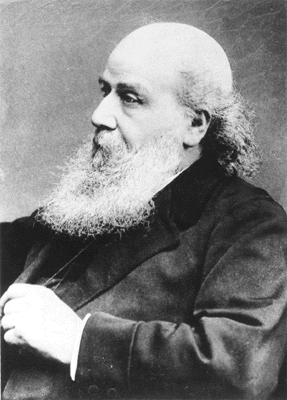|
|
Math's No. 1 Faculty MemberJames Joseph Sylvester arrived in 1876 to build an infant university
By James Stimpert |

James Stimpert, of MSEL Special Collections, is Homewood archivist. This is the first in an occasional historical series that will appear in the year leading up to the 125th anniversary of the founding of Johns Hopkins.
When James Joseph Sylvester came to The Johns Hopkins University in 1876, he was the most senior of the original faculty, in terms of age and prior accomplishments. The university's first professor of mathematics, the 61-year-old Sylvester had already had a full career in both academia and private business. Alternately brilliant and erratic, warm and irascible, benevolent and egocentric, Sylvester helped propel the infant university to the forefront of scholarly attention soon after his arrival in Baltimore.
 |
| The founding chair of the Department of Mathematics, James Joseph Sylvester came from England to Johns Hopkins after a full career in academia and business. |
Born in 1814 to the family of a Jewish merchant in London, Sylvester showed mathematical talent at an early age. Barred from most universities because of his religion, he entered the University of London at the age of 14. After a number of false starts, Sylvester passed his examinations at St. John's College, Cambridge. Because he could not subscribe to the Thirty-Nine Articles of the Church of England, however, Sylvester was denied his degree and any hope of competing for prizes and fellowships. He later succeeded in earning his bachelor's and master's degrees from Trinity College, Dublin. Seeing opportunities in the United States, he took up residence at the University of Virginia, where he assumed the chair of mathematics in 1841.
If Sylvester expected the University of Virginia to resemble the dignified atmosphere of British universities, he soon realized how wrong he was. Although he arrived to a welcome of bonfires and illuminations, he discovered that students did not regard their instructors with quite the same reverence as did their European counterparts. Known for their "drunkenness and lawlessness," the students included one person who had murdered a faculty member just prior to Sylvester's arrival. After only one year, Sylvester resigned, protesting the mild punishment given to a student who had been threatening and insubordinate to him.
Despairing of prospects in the United States, Sylvester returned in 1843 to England, where, only two years earlier, he had "burned his bridges." He found an actuarial position with a London life insurance company and eventually took a position at the Royal Military Academy in Woolwich, where he spent the next 15 years studying the theory of invariants, partition theory and polynomial equations. Forced into retirement in 1870, Sylvester seemed at the end of a creditable, although not stellar, career.
In 1875, as Daniel Coit Gilman assembled his faculty, colleagues recommended Sylvester for the chair in mathematics. Determined to find the right people even if it meant postponing instruction in a particular field, Gilman took his time evaluating the older man. Gilman wondered whether Sylvester, already 61, would have the energy to build a department from scratch and to train people to follow in his steps. Colleagues assured Gilman that the mathematician really desired a fresh start, and where better to obtain this than in a situation where he would be establishing all precedents himself?
After some difficult negotiations regarding salary (Sylvester wished to be paid in gold) and housing allowances, the parties reached a satisfactory agreement, and in May 1876 Sylvester returned to the United States. With keen insight, he chose for junior faculty positions individuals who went on to distinguished careers of their own. Although Sylvester spent only seven years at Hopkins before returning to England and semi-retirement, his effect on the university was dramatic. He founded the American Journal of Mathematics in 1877, conducted and directed extensive research in higher mathematics and championed the admission of a brilliant woman graduate student, Christine Ladd, who might otherwise have been turned away.
Sylvester was absent-minded and could focus on a problem so completely as to be oblivious to all surroundings. He was famous for stopping in midlecture when a new and irrelevant idea struck him, pursuing that thought to the bewilderment of his students. Perhaps due to his mellowing personality, these peculiarities did not offend his associates as they had in earlier years.
While working on a mathematical paper in London in February 1897, Sylvester suffered a massive stroke, which resulted in his death on March 16.
For more information on the history of Johns Hopkins, log onto archives.mse.jhu.edu:8000/ or visit the archives on A-Level, MSE Library.
| GO TO MARCH 20, 2000 TABLE OF CONTENTS. |
| GO TO THE GAZETTE HOMEPAGE. |